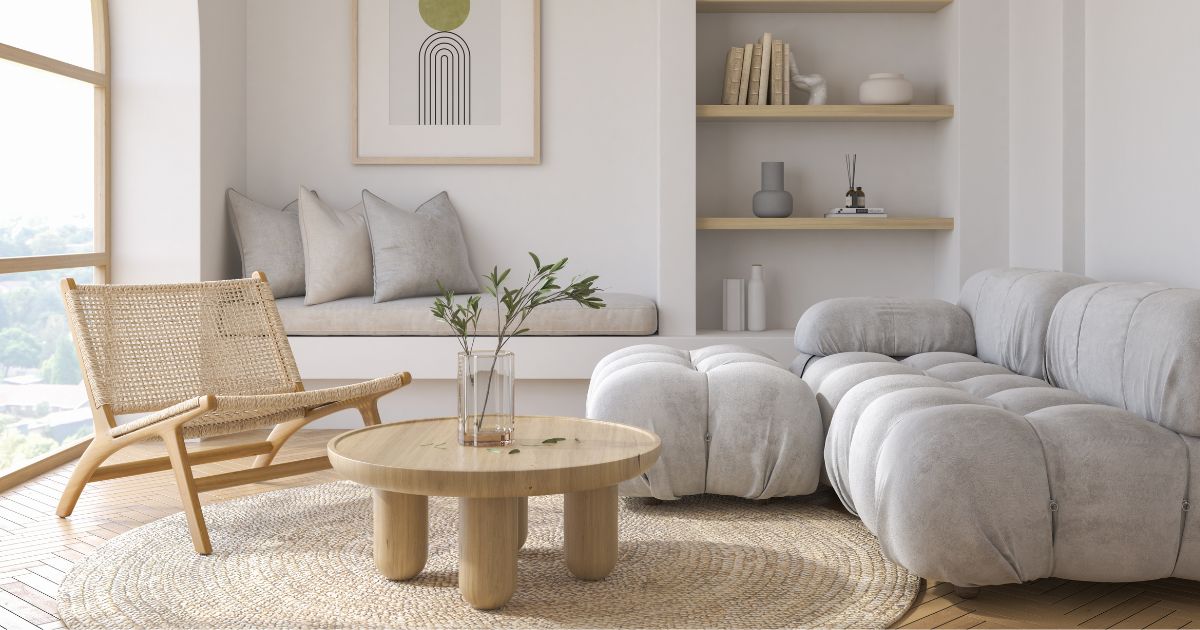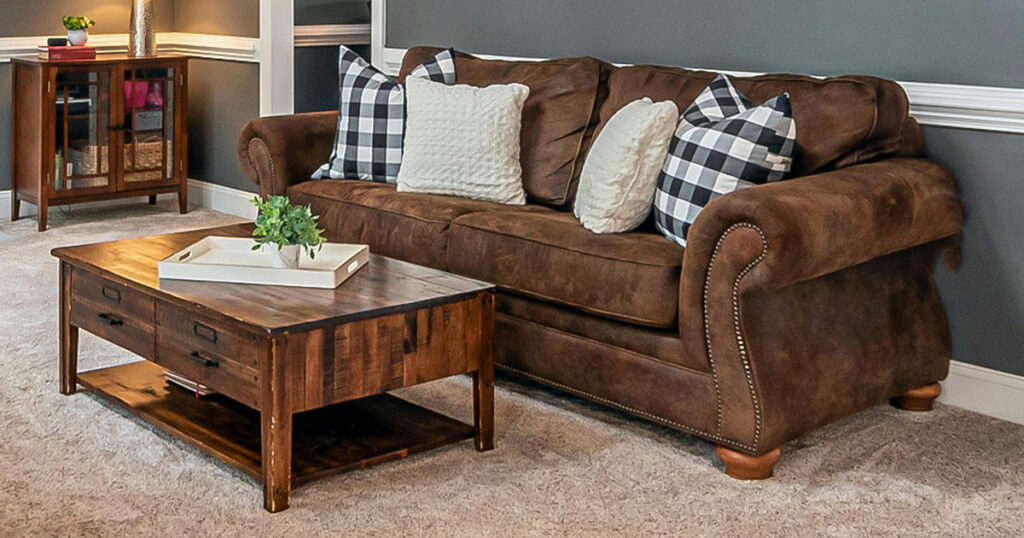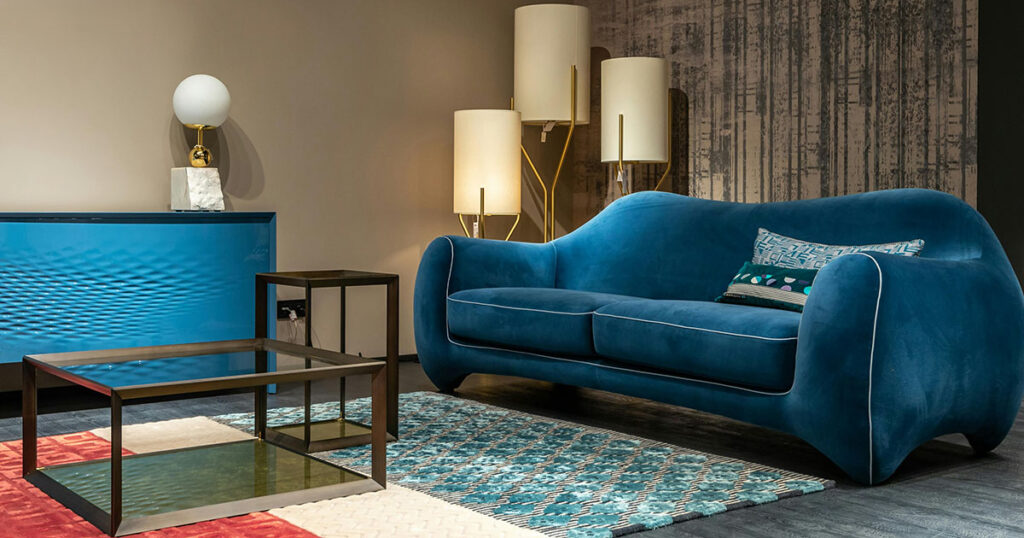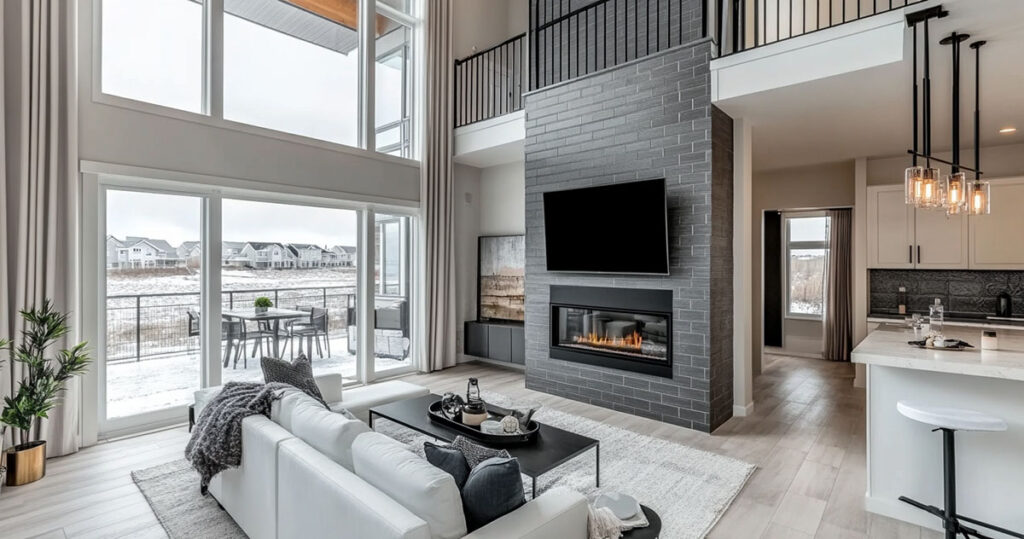Transform your Japandi interior design with the perfect rugs.
In this blog post, we’ll explore how to select rugs that blend the simplicity of Japanese style with the comfort of Scandinavian design.
You’ll learn about the ideal colors, materials, and patterns to enhance your serene space.
Discover tips on rug placement and how to create a harmonious balance.
Let’s dive in now!
Introduction to Japandi Style
Japandi style brings together the best of Japanese minimalism and Scandinavian comfort. This east-meets-west approach creates spaces that feel both serene and inviting. At its core, Japandi celebrates simplicity, natural beauty, and functional living.
The philosophy draws from Japan’s wabi-sabi (finding beauty in imperfection) and Scandinavia’s hygge (creating warmth and comfort). Japandi spaces use clean lines, minimal clutter, and quality craftsmanship to create calm environments where every item serves a purpose.
Rugs play a crucial role in Japandi interiors. They ground the space, add warmth, and contribute to the overall harmony that defines this style. A well-chosen rug doesn’t just cover your floor – it connects your furniture, softens hard surfaces, and helps create that perfect balance between minimal and cozy.
Japandi Color Palettes for Rugs
Warm Neutrals: The Foundation
Warm neutrals form the foundation of Japandi rug colors. Look for whites, off-whites, creams, and ivories that create an open, airy feel. Beige and tan tones (like sand, oatmeal, or flax) add warmth without strong color.
Soft grays also work well, providing a cooler neutral that pairs beautifully with wood elements. These neutrals can be layered together for subtle depth – imagine a rug with heathered ivory and gray yarns that mimics stones in a zen garden.
Earth Tones: Nature-Inspired Colors
Beyond neutrals, Japandi embraces earthy colors drawn from nature. Brown hues from light wood tones to medium walnut browns work exceptionally well in Japandi rugs, grounding the space and echoing natural wood elements.
Muted greens (sage, olive) and soft blues (dusty blue, slate) can appear in Japandi rugs but always in toned-down forms. These colors should feel like what you’d see on a nature walk – clay brown, fern green, or cloudy sky blue – always subtle and subdued.
Dark Accents: Creating Balance
While the overall palette stays light to mid-tone, strategic dark accents add definition to Japandi interiors. A rug might feature subtle black patterns, a charcoal border, or flecks of darker yarn woven through a neutral base.
These touches of darkness can help ground the palette and tie together other dark elements in your space, like black lamp bases or picture frames. However, use these dark accents sparingly – they should define, not dominate.
Colors to Avoid
Japandi rugs typically avoid bright, saturated colors like electric blue, neon yellow, or vibrant red. If you love a certain color, incorporate it in its most muted form and in small doses – perhaps as a faint pattern on an otherwise neutral rug.
The goal is a palette that feels calming and nature-derived. Your rug should blend seamlessly with your furniture and flooring rather than demanding attention through bold colors.
Patterns and Textures for Japandi Rugs
Patterns: Embrace Simplicity
Japandi rugs favor simplicity in pattern. Many are solid-colored or feature minimal designs that don’t overwhelm the space.
Geometric patterns with clean lines work well – think broad stripes, simple grids, or repetitive shapes like diamonds or circles in tone-on-tone execution. These patterns should add subtle interest without creating visual noise.
Organic, nature-inspired motifs can also align with Japandi sensibilities if kept subtle. A scattered pattern of stylized cherry blossoms or bamboo leaves in a low-contrast color adds an authentic Japanese touch while maintaining simplicity.
Some Japandi rugs incorporate wabi-sabi elements through imperfect or asymmetrical patterns – perhaps irregular stripes or a free-form crosshatch that feels hand-drawn. These inject personality while honoring the Japanese appreciation for imperfection.
When in doubt, choose a pattern-free rug. A solid rug in rich natural materials provides an ideal foundation for Japandi interiors, letting other elements like wood furniture or plants subtly stand out.
Textures: Add Depth Through Touch
While patterns remain understated, texture is where Japandi rugs truly shine. Since the color palette is restrained and patterns simple, texture becomes essential for adding warmth and sensory richness.
Natural fiber textures inherently bring interest. A thick wool rug adds soft, inviting texture that balances sleek furniture. Jute and sisal rugs offer coarse, earthy textures with visible weave patterns that connect the design back to nature.
Pile height and weave style create textural variety. A high-pile rug provides plush comfort in reading nooks or bedrooms, while flat-weave rugs work well in high-traffic areas while contributing an organic, handcrafted feel.
Handmade rugs often feature delightful textural quirks – slight variations in yarn thickness or subtle ribbed effects from the loom. These imperfections give the rug soul and perfectly align with wabi-sabi principles.
Consider how your rug’s texture contrasts with other surfaces in the room. If you have many smooth materials (wood, metal, leather), a more textured rug adds necessary softness. If you already have chunky throws and textured upholstery, a smoother rug might create better balance.
Materials and Construction for Japandi Rugs
Natural Fibers: The Ideal Choice
Natural materials align perfectly with Japandi philosophy. These materials bring authentic textures and connections to nature while supporting sustainability.
Wool stands as an excellent choice for Japandi rugs. Whether hand-knotted, tufted, or flat-woven, wool rugs offer durability, softness, and natural warmth. They age gracefully and can last for decades, fitting Japandi’s preference for quality over disposable decor.
Plant fibers like jute, sisal, and seagrass work beautifully in Japandi interiors. Jute brings chunky texture and golden-beige color, making it perfect for adding earthy warmth. Sisal offers durability with a finer texture, while seagrass provides a structured, hard-wearing surface.
Cotton rugs (typically flat-woven) work well in casual spaces like kitchens or children’s areas. They’re lightweight, often washable, and add a relaxed touch to Japandi rooms.
For a touch of luxury, some contemporary Japandi rugs blend wool with bamboo silk (viscose from bamboo cellulose) to create subtle sheen contrast. These blends can add gentle luster without appearing overly ornate.
Construction and Craft
Japandi celebrates craftsmanship, so handmade rugs carry special value. Hand-knotted or hand-woven rugs might show slight irregularities in weave or color – these aren’t flaws but beauty marks that channel wabi-sabi philosophy.
Machine-made rugs can work if they’re made of natural materials and have designs that appear organic rather than mechanically precise. Hand-tufted rugs offer a middle ground – they allow for simple, modern designs in wool at moderate price points.
Edge finishes impact the overall look. For Japandi, choose clean, unfussy edges – a serged edge in a matching color or a simple canvas binding in a coordinating tone. Avoid ornate borders or excessive fringe, which can conflict with Japandi’s clean aesthetic.
Consider a rug’s thickness and backing relative to your space. Japandi rooms often favor rugs that are low to medium pile rather than extremely thick ones, reflecting the clean look of Japanese tatami mats while maintaining comfort.
Size and Placement for Japandi Rugs
Sizing Principles
In Japandi interiors, proper rug sizing creates harmony and purposeful design. A well-proportioned rug brings balance while a poorly sized one can make a space feel disjointed.
For living rooms, choose rugs large enough that at least the front legs of all major furniture pieces sit on the rug. This creates a unified conversation area that feels intentional. In dining rooms, ensure the rug extends at least 24 inches beyond the table on all sides so chairs remain on the rug even when pulled out.
Leave some breathing room around your rug. A visible border of floor around the rug’s perimeter helps the room feel intentionally composed rather than carpeted wall-to-wall. This margin shows off your beautiful flooring while framing the rug as a design element.
In small spaces, opt for the largest appropriate rug to avoid chopping up the floor visually. A rug that encompasses all key furniture can actually make a small room feel larger by creating a cohesive seating arrangement.
Placement by Room Type
In living rooms, center the rug with your main seating arrangement. The rug should extend beyond the coffee table and ideally have at least the front legs of all seating on it. Align the rug parallel to walls and furniture for a neat, organized look.
For dining areas, place the rug centered under the table. Choose a durable, flat-weave wool or natural fiber rug that allows chairs to move easily while remaining on the rug when pulled out.
In bedrooms, either place a large rug under the bed that extends out on both sides and the foot, or use smaller rugs or runners on each side of the bed. Either approach adds warmth and comfort when getting in and out of bed.
Consider runners for hallways and entryways. These should run most of the hallway’s length with a small margin of visible floor on each side. Choose durable materials for these high-traffic areas.
In commercial Japandi spaces like hotel lobbies, larger rugs can define seating clusters and soften acoustics. The placement should mirror the shape of furniture arrangements and create “islands” of comfort within larger spaces.
Enhancing Japandi Aesthetic with Rugs
Creating Warmth and Harmony
Rugs transform the mood of Japandi spaces by adding both physical and visual warmth. On a practical level, rugs insulate against cold floors, making rooms more inviting. Visually, they often introduce warmer tones that balance cooler elements like white walls or concrete floors.
The texture of rugs adds essential sensory richness to minimal Japandi interiors. A thick wool rug or natural fiber weave brings tactile warmth that makes spaces feel lived-in and comfortable despite their sparse decor.
Rugs help create harmony by physically connecting disparate furniture pieces. A rug with subtle color variations might contain threads that echo both light wood furniture and darker accents, literally weaving your design elements together.
Acoustically, rugs absorb sound, creating the quieter, more serene environment that Japandi spaces aim to achieve. This hushed quality fosters relaxation and mindfulness – key values in Japandi philosophy.
Supporting Biophilic Design
Japandi interiors emphasize connection to nature, and rugs support this biophilic approach. Natural fiber rugs directly bring outdoor elements inside, creating subtle but meaningful links to the natural world.
The colors and textures of Japandi rugs often mimic natural landscapes – the sandy tones of beaches, the varied browns of wood, or the soft greens of moss. These nature-inspired elements have been shown to reduce stress and improve well-being.
The sensory experience of walking on natural fiber rugs – feeling the spring of wool or the texture of sisal – provides physical feedback that differs from synthetic materials. This tactile connection grounds us in the present moment, supporting the mindfulness aspect of Japandi design.
Enhancing Minimalism
Contrary to what some might think, rugs actually support minimalism in Japandi spaces. A simple, high-quality rug provides visual simplification by creating a continuous field of calm color or texture beneath furniture.
Rugs reduce the need for excess decor by adding texture and interest through one significant piece rather than multiple small accessories. This aligns with the Japandi principle of fewer, better items.
By helping organize space into distinct zones, rugs create order – a cornerstone of minimalist design. They make layouts feel intentional and purposeful without requiring additional furniture or dividers.
Customization Options for Japandi Rugs
Edge Finishes and Borders
The edge finish of a rug subtly affects its overall style. For Japandi interiors, choose clean, unfussy edges that complement the rug without drawing attention.
Serged edges wrap yarn continuously around the rug’s perimeter for a seamless finish. Choose serging in a color that matches your rug for an unobtrusive look that maintains clean lines.
Binding or borders frame the rug with fabric tape. For Japandi style, select narrow cotton or linen binding in a neutral tone that harmonizes with the rug color – perhaps off-white on seagrass or gray on a gray sisal rug.
If your rug has fringe, keep it minimal. Long, decorative fringes might conflict with Japandi’s clean aesthetic. Short, tidy fringe in the same color as the rug can work if it doesn’t draw too much attention.
Rug Shapes for Japandi Spaces
While rectangular rugs are most common, consider other shapes depending on your space and furniture arrangement.
Square rugs can work well in square rooms or with symmetrical furniture groupings. They provide balance and order, qualities valued in Japandi design.
Round rugs add a touch of softness to Japandi interiors by breaking up straight lines. They work beautifully under round dining tables or in reading nooks, creating gentle contrast with rectilinear furniture.
For unique spaces, custom-cut rugs can follow specific architectural features or create intentional zones. However, keep these shapes simple and functional rather than decorative or attention-seeking.
Natural Fiber Variations
Different natural fibers offer unique characteristics worth considering for your Japandi interior.
Wool comes in various grades and knot densities. Undyed wool in a mix of sheep’s natural colors creates a lovely heathered look ideal for Japandi neutrality. Loop pile or cut-and-loop combinations add texture without requiring multi-colors.
Plant fibers each bring distinct qualities: jute offers softness and chunky texture; sisal provides durability and a finer, consistent texture; seagrass brings a smooth, water-resistant surface with a slightly green tint.
Consider blended fibers for combined benefits. Wool-jute mixes offer wool’s softness with jute’s rustic texture. Cotton-jute blends provide stability with added comfort. These thoughtful combinations can offer the perfect balance for your specific needs.
Practical Tips for Rug Selection
Finding Your Perfect Japandi Rug
Start by analyzing your existing space. What colors appear in your furniture, floors, and walls? Look for rugs that complement these elements rather than compete with them. If you have light wood furniture and white walls, a warm beige or soft gray rug might tie everything together beautifully.
Consider your room’s function when selecting rug materials. High-traffic areas need durable fibers like wool or sisal, while bedrooms might benefit from softer, plush textures for comfort underfoot.
Test rug samples in your space whenever possible. Neutral colors can look dramatically different depending on your lighting and surrounding colors. What appears beige in a store might read as yellow or gray in your home.
Think about maintenance requirements. Natural fibers offer beauty and authenticity but may need specific care. Wool resists stains naturally but may shed initially. Jute shouldn’t get wet. Choose materials that match your lifestyle and cleaning preferences.
Layer rugs for added depth if you have a large space. A large natural fiber rug as a base with a smaller wool rug on top creates texture and interest while maintaining Japandi simplicity.
Ensuring Quality and Authenticity
Examine rug construction before purchasing. Hand-knotted rugs typically offer the highest quality and longevity, while hand-tufted provides good value with modern designs. Look at the back of the rug – a clearly visible pattern indicates better construction.
Check fiber quality by feeling the rug. Natural fibers should feel substantial and have variations in texture. Wool shouldn’t feel plastic or shed excessively when rubbed firmly.
For natural fiber rugs, look for good backing that won’t damage floors. Cotton or canvas backings are preferable to plastic-feeling latex that might off-gas or discolor floors.
Consider edge finishing quality. Edges should be secure and even, whether serged, bound, or finished with a small fringe. Poorly finished edges can unravel or create tripping hazards.
Support sustainable practices by choosing rugs made with natural dyes, responsibly sourced materials, and fair labor practices. Many quality Japandi-style rugs come from manufacturers committed to environmental and social responsibility.
Conclusion
Remember that Japandi celebrates quality over quantity.
Invest in one beautiful, well-made rug rather than multiple inexpensive options. Natural materials, subtle colors, and simple designs will create a timeless foundation that supports your Japandi vision for years to come.
As you continue developing your Japandi interior, let your rug serve as both a practical element and a tactile connection to nature.




